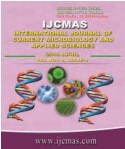


 National Academy of Agricultural Sciences (NAAS)
National Academy of Agricultural Sciences (NAAS)

|
PRINT ISSN : 2319-7692
Online ISSN : 2319-7706 Issues : 12 per year Publisher : Excellent Publishers Email : editorijcmas@gmail.com / submit@ijcmas.com Editor-in-chief: Dr.M.Prakash Index Copernicus ICV 2018: 95.39 NAAS RATING 2020: 5.38 |
Silkworm seed technology laboratory, Kodathi is producing P2 Dfls through Race maintenance programme in limited manner to supply selected Basic seed farms to rear and generate P1 seed cocoons for hybrid preparation to West Bengal in the event of seed crop failures. In the present investigation, Nistari ecotypes Chalsa, Balapur and Debra, M6DPC were evaluated almost for 5 years. The mean performance of these breeds was shown significant differences for the majority of the traits with excellent pupation rate. The effective rate of rearing/ 10,000 larvae (ERR) by is 8927 in Chalsa, 9118 in Balapur, in Debra 8898 and 8843 in M6DPC. The ERR by weight is 8.96 Kg in Chalsa, 8.66 Kg in Balapur, 8.61 Kg in Debra and 7.92 in M6DPC. The cocoon weight in Chalsa 0.800g, and 1.00g in Balapur, 1.020g in Debra, 1.060 and in M6DPC. The cocoon shell weight in Chalsa is 0.150 and in Balapur 0.150g, in Debra 0.140 and 0.140 in M6DPC. Cocoon shell ratio in Chalsa is 14.45%, in Balapur 14.42%, in Debra 14.72% and in M6DPC is 13.91. Pupation rate in Chalsa is 90.58%, in Balapur 94.15% and in Debra 95.58% and 94.65 in M6DPC. Evaluation of these P2 dfls of Nistari (Chalsa, Balapur and Debra) in West Bengal at selected Basic seed farms indicated 36.05 Kg/100 dfls with a good pupation rate of 95.7%. In Tamil Nadu, Nistari (Chalsa) revealed an average yield of 41.89 Kg/100 dfls with 95% pupation. In case of M6DPC, it revealed an average yield of 45.12 Kg/100dfls with pupation rate of 94% and other traits are on par with laboratory performance. In Andhra Pradesh, an average of 52.03 Kg/100 dfls (Chalsa) yield with 96.6% pupation rate and excellent economic traits is indication for quality seed cocoons to realize the benefit of hybrid vigour at commercial level.
 |
 |
 |
 |
 |